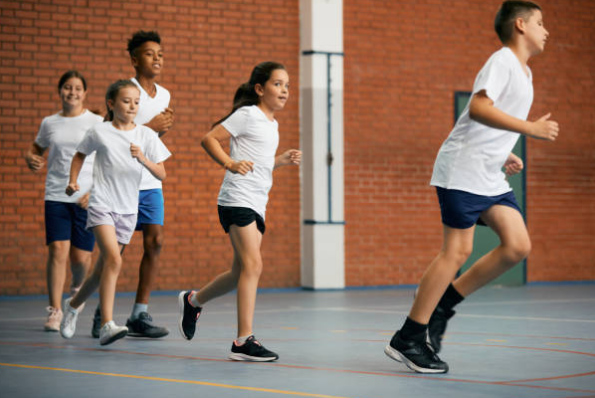Group Experiences in Health and Physical Education: Selection Considerations for Teaching Practice

Previously published in Volume 82, Issue 1
Introduction
Pairings, groups and teams are often central to how we organize or structure health and physical education (HPE) experiences. Indeed, the nature of HPE activities often requires and/or enables a social and interactive focus. Work with others is used to promote collaborative learning environments and critical thinking (Gillies, 2003). In these interpersonal working arrangements, students can be exposed to new ideas and perspectives—providing occasions to expand their understandings of HPE concepts, skills and strategies. How these groups are formed, and the impact of those decisions, are of interest to us.
Research has suggested that group experiences can serve as a backdrop or platform for the development of social skills (Bennett, 2015). Despite our tacit understandings of the benefits associated with students working with others, we often spend little time considering the implications associated with how teachers and students establish pairing, groups and teams in HPE settings (Grimminger, 2014). In many instances, and for a variety of reasons, we might choose to allow our students the opportunity to group themselves. In these situations, students make choices based on a variety of factors. In practice, and despite the intentions of teachers, these factors might include rank, value attributes, perceived skill level benefits, and social status. Without a full understanding of the motivating factors or implications related to students’ own selection decisions, we would suggest that: (a) elementary students are not equipped or prepared to make those decisions nor are they prepared to deal with the exclusionary consequences present in group/team selections, and (b) these team/group selection decisions are best left to teachers—those individuals who are charged with making sound pedagogical decisions related to establishing and maintaining a safe learning environment. The purpose of this paper is twofold. First, we briefly evaluate the implications of self-selected group/team work by exploring its role in the emotional well-being of a child. Second, we offer a series of strategies/considerations for teachers to utilize in their own classrooms.
Emotional well-being
Peer relationships are a mediating factor in a child’s emotional well-being. Children have an innate need for positive and lasting relationships; thus it stands to reason that their emotional well-being can be negatively affected by peer rejection and exclusion (DeWall & Bushman, 2011). Peer rejection refers to how much a child is disliked by her/his peers (Buhs, Ladd, & Herald, 2006; Bukowski, Hoza, & Boivin, 1993) whereas peer exclusion describes when a child is excluded from engaging with her/his peers, through means of avoiding, ignoring and refusing participation (Buhs et al., 2006). These two behaviours can occur simultaneously or independently. Research has suggested that a person experiencing peer rejection and/or exclusion will be less emotionally secure and stable (DeWall & Bushman, 2011). On the other hand, peer acceptance, validation and closeness act as a protective factor, improving an individual’s overall emotional well-being (Burkowski et al., 1993).
While the body of work addressing group/team selection in HPE is scant (Grimminger, 2014), the link between peer rejection and exclusion to self-selected groups is evident. In a 2013 study, researchers asked university students to reflect upon their experiences in school sports as a child (Cardinal, Yan, & Cardinal, 2013). Recognizing that school sports and HPE programs are different, there are parallels that can be drawn from students’ school sports experiences. Students who recalled experiences of being chosen last for sports teams “described the pain associated with the experience as being alienating, emotionally harmful, frustrating, embarrassing, diminished self-confidence, feeling hurt, mistreated, not valued, upset, sad, ashamed, worthless, unwelcome, and socially isolated” (Cardinal et al., 2013, p. 52). Moreover, and equally important, it was noted that they were less likely to engage in physical activity later on in life (Cardinal et al., 2013).
A child who is marginalized or excluded in peer pairing, groupings, or team selection has the potential to experience emotional pain and undue stress as described by the participants in the Cardinal et al. (2013) study. We would also suggest that allowing self-selection of pairing and/or grouping may have unintended consequences on students’ early academic success in HPE. Research has pointed to the links between emotional damage, peer rejection and exclusion and decreases in academic performance and school engagement (Veronneau, Vitaro, Dishion, Brendgen, & Tremblay, 2010). Moreover, we find conformity in the literature suggesting that students who experience chronic peer rejection and exclusion, beginning as early as kindergarten, may be more likely than others to have lower overall success and engagement in school (Buhs et al., 2006). Further, evidence has suggested that HPE students may feel and experience undue stress when teachers hand over grouping responsibilities to the students (Grimminger, 2014). Within HPE settings, the teacher has the ability to, in part, mitigate and potentially eliminate scenarios where peer rejection and exclusion—products of student self-selection of groupings and teams—may impact students’ well-being.
Selection considerations to support HPE teaching practice
Establishment of norms
At the start of the school year, and routinely throughout the year, HPE teachers are encouraged to establish and reinforce selection norms together with their students—norms that get at the heart of how and why pairings, groupings and team selection decisions will be made. As noted in this article, student selection, and more specifically peer selection, has an impact on students’ well-being and academic performance. Establishing group selection norms in HPE settings may help teachers set aside intuitive tendencies and tacit understandings related to peer selection in favour of a more systematic approach that aims to ensure students are grouped with quality HPE pedagogy and student well-being in mind (Barrett, 2015).
Diagnostic assessments and student groupings
In HPE settings, diagnostic assessments could be expanded to include an assessment of the impacts of student pairings, groups and teams on student learning. Across a wide variety of activities, students will have different concerns or needs in pairing, groups and teams. Teachers, with their students, are encouraged to address students’ particular needs using a variety of diagnostic assessments; these may include the use of exit cards, questioning, self-assessments, and large- and small-group conferencing. Understandings gained could lead to more carefully designed HPE group experiences.
Selection ‘cheat sheet’
HPE teachers may also consider putting together a cheat sheet of pairings, groupings and teams that put students in the best possible situation to be successful. As with all planning and teaching in HPE, reflection will inevitably lead to grouping changes being made to support students’ emotional, social and academic success in HPE settings. As the HPE teacher learns more about her/his students, this cheat sheet can be further tailored to particular types of activities and games comprising a quality HPE program. Finally, this type of resource can also be left for supply teachers to help mitigate potential issues that might arise as a result of student groupings.
Concluding thoughts
Pairings, group and team experiences can offer students meaningful opportunities to develop positive and life-sustaining interpersonal skills. Within quality HPE programs, we maintain that these important grouping decisions should be made solely by HPE teachers—those individuals who are responsible for ensuring safe, positive and enriching HPE experiences. We have suggested but a few examples of selection considerations or strategies that can be utilized by HPE teachers. We also believe that student grouping choices and decisions need to be organized and monitored through an HPE teacher-developed process—one that is tangible and systematic so that students’ well-being and academic success are logical products of quality HPE interpersonal experiences.
References
Barrett, J.M. (2015). School-based physical activity: Planning with student motivation in mind. Teaching and Learning, 10(1), 1-20.
Bennett, T. (2015). Group work for the good: Unpacking the research behind one popular classroom strategy. American Educator, 39(1), 32-37.
Buhs, E.S., Ladd, G.W., & Herald, S.L. (2006). Peer exclusion and victimization:Processes that mediate the relation between peer group rejection and children’s classroom engagement and achievement. Journal of Educational Psychology, 98(1), 1-13.
Bukowski, W.M., Hoza, B., & Boivin, M. (1993). Popularity, friendship, and emotional adjustment during early adolescence. New Directions for Child and Adolescent Development, 60, 23-37.
Cardinal, B.J., Yan, Z., & Cardinal, M.K. (2013). Negative experiences in physical education and sport. Journal of Physical Education, Recreation and Dance, 84(3), 49-53.
DeWall, C.N., & Bushman, B.J. (2011). Social acceptance and rejection: The sweet and the bitter. Current Directions in Psychological Science, 20(4), 256-260.
Gillies, R.M. (2003). Structuring cooperative group work in classrooms. International Journal of Educational Research, 39, 35–49.
Grimminger, E. (2014). Getting into teams in physical education and exclusion processes among students. Pedagogies: An International Journal, 9(2), 155-171.
Veronneau, M., Vitaro, F., Dishion, T.J., Brendgen, M., & Tremblay, R.E. (2010). Transactional analysis of the reciprocal links between peer experiences and academic achievement from middle childhood to early adolescence. Developmental Psychology, 46(4), 773.










